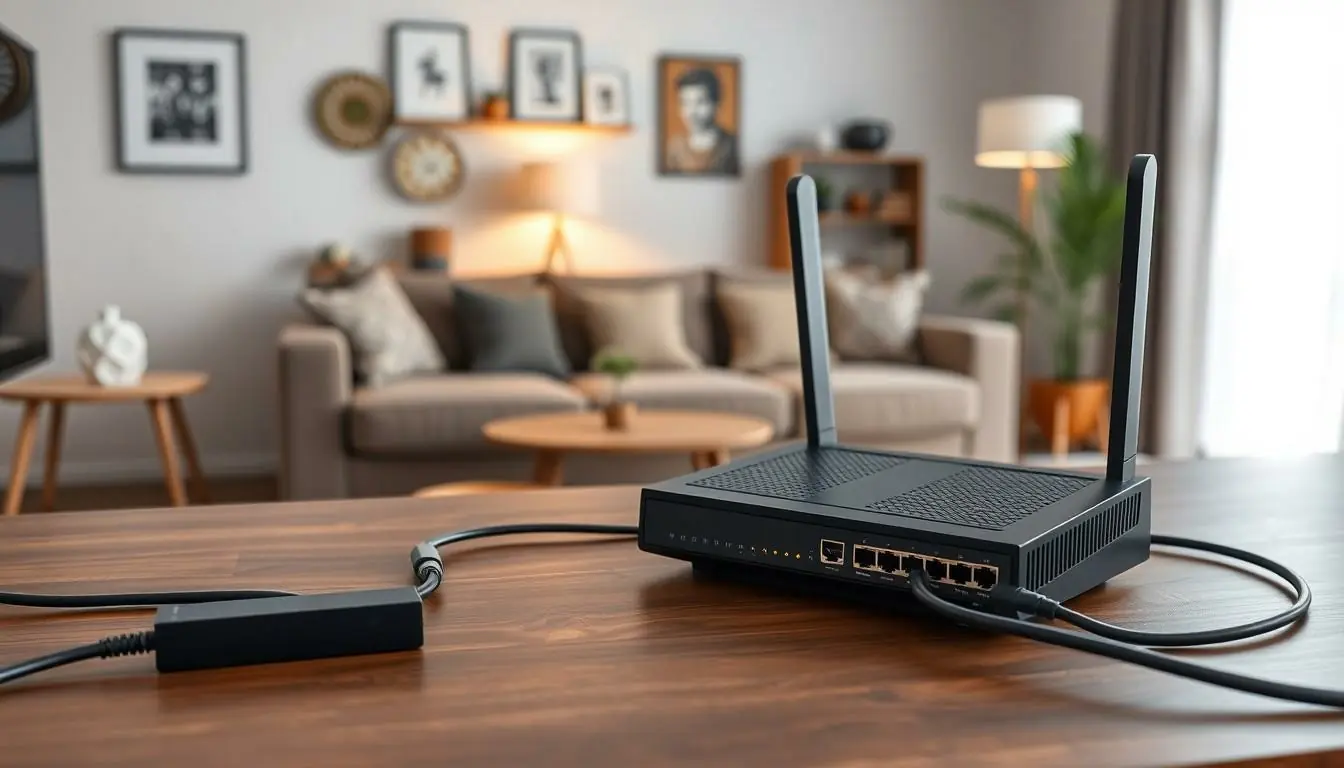Table of Contents
ToggleIn today’s digital age, home networking is as essential as a good cup of coffee on a Monday morning. Whether it’s streaming the latest binge-worthy series or video chatting with family, a solid home network keeps everything running smoothly. But let’s face it, setting up a home network can feel like trying to solve a Rubik’s Cube blindfolded.
Home Networking Basics
Understanding home networking is essential in today’s digital environment. A robust network connects devices and enhances their functionality.
What Is Home Networking?
Home networking refers to linking multiple devices within one location. This setup facilitates communication between computers, smartphones, smart TVs, and other devices. Users access shared resources, such as printers and internet connections. Various networking types, including wired, wireless, and hybrid systems, exist. Wired networks typically employ Ethernet cables, ensuring stability. Wireless networks use Wi-Fi to connect devices without physical connections, offering more flexibility.
Benefits of a Home Network
A home network provides numerous advantages that enhance everyday activities. Improved connectivity supports activities like streaming HD videos and playing online games seamlessly. Increased security allows users to safeguard personal data from external threats. Sharing files and printers becomes effortless in a home environment, saving time and resources. Additionally, controlling smart home devices remotely boosts convenience and automation in daily life. Home networking ultimately fosters a connected lifestyle, improving efficiency and enjoyment.
Essential Components of Home Networking

Home networking relies on specific components to function effectively. Understanding these components helps build a stable and efficient system.
Router and Modem
A router connects various devices to the internet while a modem communicates with the internet service provider. Most setups include a combined modem-router unit, simplifying connectivity. This unit facilitates simultaneous internet access throughout the home for devices like smartphones, laptops, and smart TVs. Choosing a high-quality router enhances performance, allowing for faster data transfer and better coverage. Many models offer advanced features such as Quality of Service (QoS), which prioritizes bandwidth for activities like gaming and streaming.
Networking Cables
Networking cables connect devices directly to the router or switch, ensuring a reliable and speedy connection. Ethernet cables, commonly referred to as Cat5e or Cat6, transmit data with minimal interference. Users benefit from wired connections, especially in environments with numerous devices, as they reduce latency and increase upload and download speeds. Lengths vary, allowing flexibility in cable placement. Ideally, selecting high-quality cables maximizes network performance and efficiency, particularly for bandwidth-intensive tasks.
Network Switches and Access Points
Network switches expand the number of devices that connect directly to the home network. They allow multiple wired devices to communicate efficiently, acting as central hubs. Access points extend wireless coverage, improving signal strength in larger homes. This combination enhances connectivity, ensuring all devices maintain signals in every room. Incorporating managed switches gives users control over network traffic, prioritizing device access as needed. Ultimately, switches and access points play an essential role in boosting overall performance and extending coverage.
Setting Up Your Home Network
Setting up a home network involves planning and configuration to ensure effective connectivity and performance. Attention to detail can make the process smoother.
Planning Your Network Layout
Start by identifying where devices will be situated throughout the home. Prioritize high-usage areas like living rooms and home offices for optimal performance. Next, consider the devices needing connections, such as computers, smart TVs, and gaming consoles. Place the router centrally to maximize signal distribution. Wireless access points can extend coverage in larger homes, ensuring all areas receive a strong signal. Minimize obstacles like walls and large furniture that can disrupt the signal. Thus, planning the layout plays a crucial role in achieving a reliable network.
Configuring Your Router
Access the router’s settings through a web browser using its IP address. Change the default administrator username and password to enhance security. Assign a unique name to the Wi-Fi network, also known as the SSID, for easy identification. Choose a strong password that combines letters, numbers, and symbols. Enabling WPA3 security offers better protection against unauthorized access. Adjust the channel settings to minimize interference from neighboring networks, especially in densely populated areas. Lastly, consider updating the firmware regularly to benefit from performance enhancements and security fixes. Configuring the router correctly ensures a secure and efficient home network.
Wireless vs. Wired Networking
Understanding the differences between wireless and wired networking is crucial for setting up an effective home network. Each type offers unique benefits that cater to various needs.
Advantages of Wireless Networking
Wireless networking provides flexibility by allowing devices to connect without physical cables. Users can easily move devices throughout the home while maintaining a stable internet connection. Convenience plays a key role; families can connect multiple devices simultaneously, from smartphones to smart TVs, without worrying about cable clutter. Many modern devices support Wi-Fi standards, which enhance speed and range. Additionally, wireless networks simplify the setup process, making it easier for non-technical users to establish their networks. It’s ideal for households with devices spread across rooms or floors, as the router’s signal can reach multiple areas.
Advantages of Wired Networking
Wired networking ensures stability by providing a direct connection through Ethernet cables. Consistent speed is a hallmark, particularly for bandwidth-intensive tasks like gaming or streaming. Interference from other electronic devices is minimal in wired setups, leading to less latency and reliable performance. Data transfer rates remain high, accommodating heavy usage without slowing down. Security tends to be stronger; unauthorized access is more challenging without physical access to the network. Wired networks are ideal for stationary devices, such as desktop computers or gaming consoles, that benefit from uninterrupted connectivity and lower susceptibility to external interference.
Securing Your Home Network
Securing a home network is essential for protecting personal information and connected devices from cyber threats. A well-secured network prevents unauthorized access and ensures a safer online experience.
Importance of Network Security
Network security is crucial for safeguarding sensitive data, including personal and financial information. Without proper measures, cybercriminals can exploit vulnerabilities, leading to identity theft or data breaches. Statistics from cybersecurity experts indicate that around 43% of cyberattacks target small businesses, highlighting the universal risk. Furthermore, connected smart devices often serve as entry points for hackers, making robust network security a non-negotiable requirement.
Tips for Securing Your Network
Implementing effective security measures strengthens a home network’s defenses. First, change the default router login credentials to prevent unauthorized access. Second, use WPA3 encryption to encrypt data transmitted over Wi-Fi, making it harder for hackers to intercept information. Third, update router firmware regularly to patch vulnerabilities. Fourth, create a separate guest network for visitors, ensuring that main network devices remain protected. Fifth, regularly monitor connected devices to detect suspicious activities. Adopting these strategies helps maintain a secure and reliable home network.
Troubleshooting Common Issues
Troubleshooting common issues is essential for maintaining a reliable home network. Identifying connectivity problems provides the first step in resolving network disruptions.
Identifying Connectivity Problems
Connectivity problems often stem from basic issues. Checking physical connections is crucial; ensure all cables are securely plugged in and not damaged. Next, look at device status; restarting devices like routers and modems can quickly solve minor glitches. Signal strength significantly impacts connectivity; using a Wi-Fi analyzer app helps locate dead zones. Lastly, interference may occur from appliances or nearby networks; changing the router’s channel can improve performance.
Fixing Slow Network Speeds
Slow network speeds frustrate users and disrupt activities. First, check the internet speed using a reliable speed test; this verifies if the issue lies with the internet service provider. Router placement matters; positioning it centrally often enhances signal reach throughout the home. Bandwidth-heavy applications can slow speeds; limiting their use during peak hours may alleviate congestion. Upgrading router firmware regularly helps improve performance and security. Lastly, consider switching to wired connections for devices needing stable speeds, such as gaming consoles and computers.
A well-structured home network is essential for modern living. It enhances connectivity and security while simplifying daily tasks. By understanding the components and configuration of home networking, individuals can create a seamless experience for streaming, gaming, and smart home management.
Investing time in planning and securing the network pays off in performance and peace of mind. Regular maintenance and troubleshooting keep the network running smoothly, ensuring that all devices remain connected and secure. Embracing these practices leads to a more efficient and enjoyable digital lifestyle.





